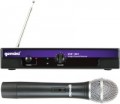Microphone directivity
Directionality describes the ability of a microphone to pick up sounds coming from different directions, more precisely, the dependence of sensitivity on the direction from which the sound comes.
—
Unidirectional. As the name implies, these microphones are capable of picking up sound coming from only one side. Note that the coverage area itself can be quite wide, but anyway it is located “in front” of the microphone. Unidirectional models are very convenient for the perception of sound from a single source, with maximum clipping of ambient noise.
—
Bidirectional. This term in our case means two types of microphones. The first option is the classic bidirectional models, designed for the possibility of normal perception of sound from two opposite sides — roughly speaking, "front" and "rear"; at the same time, dead zones are formed on the sides, from where the sound is practically not perceived. This format of work can be useful, for example, for broadcasting a dialogue in a radio station studio, or when simultaneously recording two voices on one microphone. The second variety is microphones with a pair of capsules directed at an angle to each other (most often perpendicular); a similar design is used in models with a stereo recording function.
—
Omnidirectional. Also, this variety is called "non-directional", which also to a certain extent ch
...aracterizes its features. Such microphones do not have a clearly defined directionality — they perceive the sound coming from any direction with full sensitivity. An example of a situation where this format might be useful is a recording of a roundtable discussion.
Note that while most microphones only work in one directional pattern, some models support multiple directional patterns, with the ability to switch between them as desired by the user (see Features/Characteristics). The methods of such switching can be different: in some models it is enough to move the switch, in others you need to change the capsule.Directional pattern
The polar pattern of a unidirectional microphone (see above). There are models with
DN switching.
By itself, such a diagram is a graph of sensitivity versus direction, built in the so-called polar coordinate system. For unidirectional models, there are three main options for the shape of the line on such a chart:
—
Cardioid. A chart shaped like an inverted heart symbol (hence the name). Microphones with these characteristics cover a fairly large area in front, which makes it difficult to filter out extraneous sound sources that are close to the main source. At the same time, they are completely insensitive to sound coming from the rear.
—
Supercardioid. These mics have a narrower front coverage than "classic" cardioid mics, making it easier to pick up directional sound. The downside of this is some (albeit rather low) sensitivity to sound coming directly from behind.
—
Hypercardioid. The hypercardioid pattern further narrows the microphone's sensitivity zone in the front (compared to the supercardioid pattern), but widens this zone in the back.
Frequency range
The range of audio frequencies normally perceived and processed by a microphone.
The wider this range — the fuller the signal, the less likely that too high or low frequencies will be missed due to the imperfection of the microphone. However, in this case, it is worth considering some nuances. First of all: a wide frequency range in itself does not guarantee high sound quality — a lot also depends on the type of microphone (see above) and its frequency response, not to mention the quality of other components of the audio system. In addition, a large width is also not always really necessary. For example, for normal transmission of human speech, a range of 500 Hz — 2 kHz is considered sufficient, which is much narrower than the general range perceived by the human ear. This general range, in turn, averages from 16 Hz to 22 kHz, and also narrows with age. Do not forget about the features of the equipment to which the microphone is connected: it is hardly worth specifically looking for a model with an extensive range, if, for example, the amplifier to which it is planned to be connected severely “cuts off” the frequencies from above and/or below.
Cable length
This parameter directly affects the freedom of movement and ease of use: the farther the microphone can be taken from the connection point, the more convenient it is, especially when used in large spaces.
Range
This parameter directly affects the freedom of movement and ease of use: the farther the microphone can be taken from the signal receiver, the more convenient it is, especially when used in large spaces. At the same time, it should be taken into account that manufacturers indicate the distance under the most favorable conditions (no obstacles, the transmitter is fully charged, etc.).

